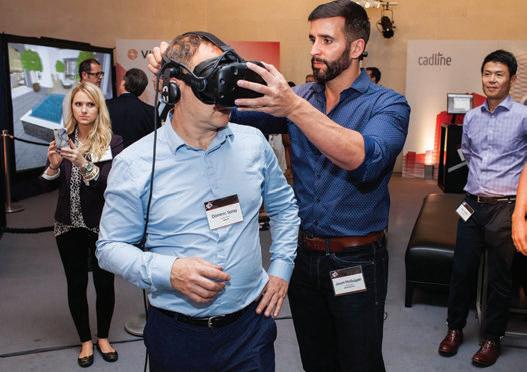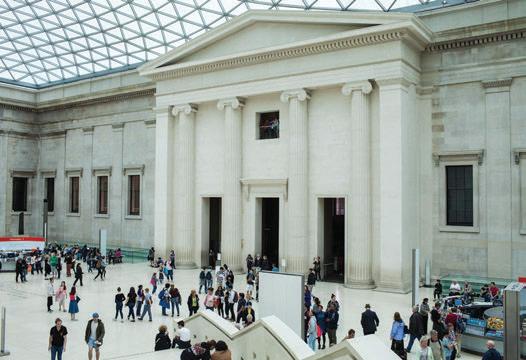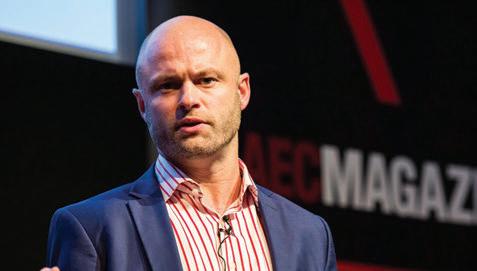
8 minute read
conference
NXT BLD conference
On June 28, The British Museum opened its doors for NXT BLD, AEC’s advanced technology event. Martyn Day looks at the highlights and explores what’s coming next, both in terms of technology beyond BIM and future NXT BLD events.
AEC Magazine has been dedicated to covering BIM and related 3D design technologies for almost 20 years. While the industry has taken a long time to start the transition, we are now seeing mass adoption, together with owners and Governments mandating its use in project delivery. With BIM tools and processes becoming common platforms, our editorial team is now looking at what technologies are coming next to complete this move from digital design to digital fabrication.
Our sister publication, DEVELOP3D has already seen the transformation of the manufacturing sector as it too moved from 2D drawings to 3D modelling, 3D simulation and analysis to computer-controlled manufacturing, from phones to aeroplanes. It seems clear to us that the building industry is now set for another revolution as model-based design can drive everything from virtual experiences, to fabrication and assembly systems.
With this in mind, we felt that the very frequently held BIM events, while importantly dealing with evangelism or some of the more detailed issues that still face BIM workflows, didn’t really address future technologies that are very rapidly becoming available to dramatically link the design data to the real world.
NXT BLD (Next Build) was held on 28 June at the British Museum with a selected audience of 250 delegates from leading UK AEC firms, and focussed on these new technologies and processes which have moved from science fiction to science fact, through the views of industryleading experts and practitioners. We are now releasing the speaker videos for all our readers to view (see page 28).
Future NXT BLD events will cover complementary technologies which are at varying levels of maturity but which will all contribute to fleshing out digital design and construction and leverage the cost and effort it has taken to move to a modelling paradigm vs drawings. The key topic areas we have identified are as follows: Photorealistic rendering and rendering in white Animation and story telling Virtual Reality (VR) Augmented Reality (AR) Mixed Reality (MR) Computational geometry / Generative Design AI and machine learning Rapid reality capture to model Laser scanning Photogrammetry Smart cities Collaboration tools 3D printing models & buildings Simulation Model to fabrication – CNC machines and robots 4D/5D construction Internet of Things (IoT)
For our first event, we concentrated on a number of these topic areas and assembled a line-up of speakers experimenting or developing solutions in Virtual Reality, Augmented Reality, scanning, GPU rendering, hardware, computational design and Artificial Intelligence (AI).
VR and AR: Virtual Reality and Augmented Reality are undoubtedly two of the hottest topics in the AEC space at the moment and many firms are trying to work out their strategy on deployment. Again, here our industry is benefitting from the commoditisation which the games market continues to drive, such as ever faster GPU and graphics to low-cost high resolution headsets. BIM firms are already producing the core 3D geometry — all that’s missing is easy bi-directional access to Virtual Reality systems and better collaborative tools. This is coming and we expect the majority of AEC firms to have VR within their design process in the next decade.
Augmented Reality may well be an even bigger deal with uses on-site during fabrication and maintenance. However the headsets here are still fragile and expensive but there are big steps forwards coming in the next year with lower-cost, higher resolution systems coming to market.
Rendering and hardware: While the industry has been talking cloud for the past five years, with relatively little to show for it, VR, AR and the need for near-instant photorealistic images continue to drive the workstation market. With so many subsystems undergoing constant change — CPU, memory, storage and graphics — it’s important to know which configurations will give the best results for high-end modelling and visualisation applications.
Scanning, photogrammetry and drones
Surveying and measurement are becoming increasingly viable throughout the building process and with remote technologies such as drones, laser scanners and highly accurate photogrammetry, it’s possible to keep a constant eye on progress and quality at each stage of the process with daily or hourly site models. With technologies such as Artificial Intelligence, it’s even possible to locate materials on site and estimate quantities and locations.
Robots, 3D print and fabrication:
Possibly the most ‘far out’ topic but surprisingly many firms are working on connecting BIM to fabrication machines, as well as delivering automation on-site. We already have a few 3D printed buildings in Dubai and China appears to lead the way in experimentation, but there are already brick laying robots and a number of UK firms are using robots to automate some new manufacture processes.




Tim Geurtjens, MX3D
In this inspirational talk, Tim shares his thoughts on the latest developments in Digital Fabrication and where he thinks things will go in the future. He explains how he was drawn into advanced robotics to develop the MX3D printers that can print metal objects of theoretically unlimited size, and presents MX3D’s plan to ‘print’ the first steel bridge in the world over one of the oldest canals in Amsterdam. The ambitious project is set for completion in 2018. Essential viewing. tinyurl.com/NXTBLD-Tim
Arthur Mamou-Mani, Mamou-Mani
The future of construction will be in robotic technologies, explains architect and digital fabrication specialist Arthur Mamou-Mani, as he introduces a project he’s carrying out with Arup to develop a robot capable of constructing and deconstructing buildings. Arthur captivates the audience as he demonstrates the cyclical nature of the building process and how demolition can be anticipated in the spirit of our new circular economy. tinyurl.com/NXTBLD-Arthur
Tom Greaves, DotProduct
Until recently, we’ve needed strong muscles, a fat wallet and patience to capture and consume the 3D reality of built environments, explains Tom. Laser scanning a construction site, for example, typically means a $50k+ investment and heavy equipment needs to be carted around the job site. In his presentation Tom shows how a new generation of mobile devices equipped with low-cost 3D sensors and computer vision software can deliver position tracking and 3D reconstruction in real time. And, best of all, they can be operated by anyone. tinyurl.com/NXTBLD-Tom
Faraz Ravi, Bentley Systems
Faraz presents the latest developments in Reality Modelling and explores how these advancements are changing the way we virtualise the environment to drive greater efficiency and resilience in our infrastructure. He shows new hybrid technologies that allow firms to get the best from both laser scanning and photogrammetry (even with photos taken with an iPhone) and explains why he believes there is an unprecedented opportunity in the advancing intersection of autonomous unmanned vehicles, sensing technology and algorithms. tinyurl.com/NXTBLD-Faraz
Mike Leach, Lenovo
Mike presents the key technology developments driving the workstation marketplace today and, more importantly, how these will impact your AEC workflows, from CAD and BIM to rendering and VR. Learn what to look out for, where to invest your hard-earned budgets and how to best configure your next workstation investment. tinyurl.com/NXTBLD-Mike










Martin McDonnel, Soluis / Sublime
Martin introduces the three ‘Rs’ — Augmented, Mixed and Virtual Reality — and how these technologies and others are driving a number of projects at Soluis and Soluis subsidiary, Sublime. Two projects that stand out in this compelling talk are a design viz project for Radisson RED that used Unreal Engine to instantly render images and movies, whilst making edits in real time, and the Augmented Worker, a project that explores the tools needed for effective use of AR on the construction site for digital job guidance, on site visualisation and more. tinyurl.com/NXTBLD-Martin
Dan Harper, Cityscape
VR is here and the buzz has been substantial. But is it something that you should be using or is it just a gimmick? How do I use it and, perhaps most importantly, why should I be using it? However, the question that supercedes all others, says Dan, is how can VR and real-time technologies generate value within a design business? tinyurl.com/NXTBLD-Dan
Paul Nichols, Skanska
Paul explains how Skanska is utilising the latest VR and AR technologies to influence behaviours on site and to assist its next generation of engineers in visualising their designs and for interaction and learning. By using VR for learning, for example, Skanska has found construction workers are able to retain site training info for longer as VR uses a different part of brain. Paul also shares how Skanska is testing the latest Mixed Reality tech and where it can be applied. tinyurl.com/NXTBLD-Paul
Rob Charlton, Space Group
From Reality Modelling and drones to VR and AR, Rob gives a critical review of current digital construction technologies. He also gives predictions on emerging AI technologies and how they will transform current building methods and revolutionise project planning, management and delivery. It’s not about telling the computer what to do, he says, it’s about telling it what we want to achieve. tinyurl.com/NXTBLD-Rob
More to come...
Check out the NXT BLD website over the coming weeks where we will be adding more video content. nxtbld.com










